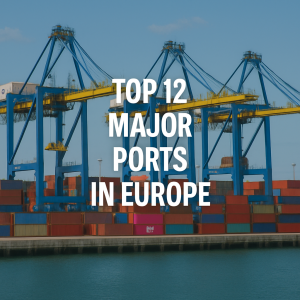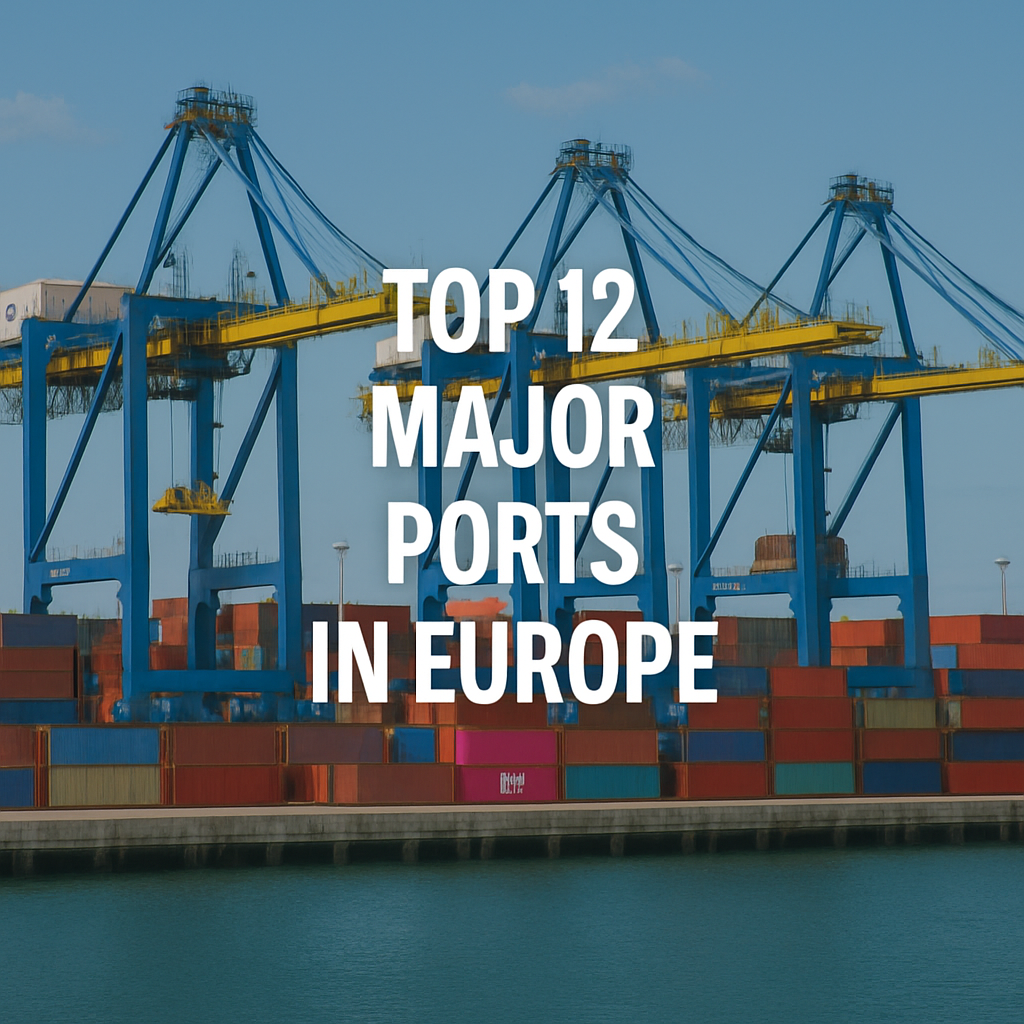Explore the top 12 major ports in Europe driving trade, innovation, and sustainability. This in-depth guide covers cargo volumes, strategic roles, digitalization, and the future of European maritime logistics.
Why European Ports Matter in Modern Maritime Operations
Europe’s seaports form the backbone of the continent’s supply chain, enabling over 90% of its external trade and 40% of its internal market exchanges (European Sea Ports Organisation, 2023). Strategically located on the Atlantic, North Sea, Baltic, and Mediterranean coasts, European ports are hubs for innovation, decarbonization, and global logistics.
In recent years, European ports have evolved beyond cargo gateways into smart, sustainable ecosystems. With growing attention on emissions reduction, automation, and geopolitical resilience, understanding the region’s leading ports is crucial for maritime professionals, students, and policymakers alike.

1. Port of Rotterdam (Netherlands)
- 2023 Cargo Volume: Over 440 million tonnes
- Significance: Largest seaport in Europe
- Strengths: Smart Port initiatives, deep hinterland rail and barge connections, advanced hydrogen terminals
- Innovation: Digital twin infrastructure and PortXL accelerator
Website: https://www.portofrotterdam.com
2. Port of Antwerp-Bruges (Belgium)
- 2023 Cargo Volume: Approx. 287 million tonnes
- Recent Merger: Antwerp and Zeebrugge unified into one port (2022)
- Focus Areas: Chemical products, breakbulk, automotive logistics
- Sustainability: Hydrogen import hub and carbon capture pilot projects
Website: https://www.portofantwerpbruges.com
3. Port of Hamburg (Germany)
- 2023 Cargo Volume: Approx. 114 million tonnes
- Strengths: Germany’s largest universal port, strong rail connectivity
- Tech Initiatives: SmartPORT logistics system, 5G-enabled terminal zones
- Sustainability: Shore power expansion and emission monitoring tech
Website: https://www.hafen-hamburg.de
4. Port of Algeciras (Spain)
- 2023 Volume: Around 110 million tonnes
- Role: Mediterranean transshipment hub near Strait of Gibraltar
- Assets: Container, ro-ro, energy cargo, LNG bunkering
- Digitalization: Blockchain-based container management systems
Website: https://www.apba.es
5. Port of Marseille-Fos (France)
- 2023 Volume: Approx. 78 million tonnes
- Focus: Energy cargo, containers, and ro-ro traffic
- Notable Project: Fos 4.0 digital logistics cluster
- Decarbonization: Onshore power systems and hydrogen corridor pilots
Website: https://www.marseille-port.fr
6. Port of Valencia (Spain)
- 2023 Volume: Approx. 79 million tonnes
- Profile: Leading Spanish container port
- Sustainability Goal: Carbon-neutral by 2030
- Digital Tools: Port Community System, IoT sensors for cargo flow
Website: https://www.valenciaport.com
7. Port of Piraeus (Greece)
- 2023 Volume: Approx. 63 million tonnes
- Ownership: Majority stake held by COSCO (China)
- Strategic Role: Gateway from Asia to Europe via Suez
- Investment Focus: Terminal automation, railway upgrades
Website: https://www.olp.gr
8. Port of Gdansk (Poland)
- 2023 Volume: Over 81 million tonnes
- Growth Driver: Energy cargo and Baltic trade expansion
- Modernization: Deepwater container terminal expansion
- Geopolitical Role: Alternative gateway amid Black Sea disruptions
Website: https://www.portgdansk.pl
9. Port of Le Havre (France)
- 2023 Volume: Approx. 65 million tonnes
- Part of HAROPA: Le Havre–Rouen–Paris port complex
- Initiatives: Smart corridor to Paris, green shipping pilot
- Strategic Location: Close to UK and Benelux markets
Website: https://www.haropaport.com
10. Port of Bremerhaven (Germany)
- 2023 Volume: Approx. 60 million tonnes
- Specialization: Automotive exports, containers
- Tech Projects: AI for berth allocation, automated cranes
- Collaboration: Fraunhofer Institute research programs
Website: https://www.bremenports.de
11. Port of Constanța (Romania)
- 2023 Volume: Approx. 68 million tonnes
- Importance: Eastern Europe’s Black Sea gateway
- Wartime Logistics: Crucial for Ukrainian grain exports amid Black Sea blockades
- Upgrades: Danube River connections and IT system revamp
Website: https://www.portofconstantza.com
12. Port of Klaipėda (Lithuania)
- 2023 Volume: Approx. 45 million tonnes
- Strategic Edge: Northernmost ice-free Baltic port
- Resilience: Critical NATO and EU logistics hub
- Modernization: LNG terminal, cargo digitization tools
Website: https://www.portofklaipeda.lt
Case Studies in Innovation and Resilience
Rotterdam: Leader in Smart Port Innovation
The Port of Rotterdam’s digital twin program enables virtual simulations of port operations in real-time. This innovation enhances congestion management, environmental compliance, and long-term capacity planning.
Piraeus: Strategic Geopolitical Asset
COSCO’s investments turned Piraeus from a modest regional hub into a top European port. It now serves as a key Belt and Road node, linking Chinese trade to Europe’s core rail and road corridors.
Gdansk: Baltic Expansion Amid War
In response to Russian aggression in Ukraine, Gdansk ramped up its capacity to handle energy, grain, and container shipments rerouted from Black Sea ports. It underscores ports’ roles in geopolitical resilience.
FAQs
1. Which is the largest port in Europe? The Port of Rotterdam remains Europe’s largest in total tonnage and container throughput.
2. Are European ports prepared for decarbonization? Many are. Ports like Antwerp-Bruges, Hamburg, and Valencia are piloting hydrogen, electrification, and carbon capture technologies.
3. How are ports digitizing? Smart Port tools include IoT-based cargo tracking, AI for berth planning, blockchain documentation, and digital twins.
4. Are European ports interconnected? Yes. The TEN-T (Trans-European Transport Network) integrates ports with rail, road, and inland waterways across the EU.
5. What are the biggest challenges facing these ports? Labor shortages, environmental regulations, cyber threats, and geopolitical instability.
6. How are ports responding to global supply chain shocks? By enhancing inland logistics, increasing resilience via redundancy (e.g., alternate ports), and digitizing operations for agility.
7. Can smaller ports compete? Yes, by specializing in niches like ro-ro, LNG, or as feeder hubs supporting mega-ports through short-sea shipping.
Conclusion
Europe’s top 12 ports are not just cargo gateways—they are innovation laboratories, climate action hubs, and geopolitical anchors. From Rotterdam’s digital twin to Klaipėda’s strategic resilience, each port plays a critical role in shaping global maritime trade.
As the EU pushes forward with its Green Deal and the shipping sector embraces decarbonization, these ports are leading the charge through collaboration, smart technologies, and sustainable investments.
Call to Action: Stay ahead by tracking developments via port authority websites, ESPO reports, and EU maritime policy updates. Whether you’re a student, port planner, or maritime executive, Europe’s ports offer valuable case studies in navigating change.
References
- European Sea Ports Organisation (ESPO). (2023). Annual Port Performance Report. https://www.espo.be
- Port Authority Websites (Listed Above)
- UNCTAD. (2023). Review of Maritime Transport. https://unctad.org
- Lloyd’s List Intelligence. (2023). European Port Rankings. https://lloydslist.maritimeintelligence.informa.com
- DNV. (2023). Port Sustainability and Decarbonization Trends. https://www.dnv.com
- European Commission. (2024). TEN-T Network and Port Infrastructure. https://transport.ec.europa.eu

